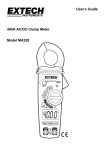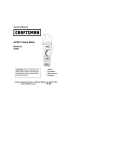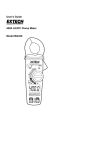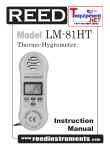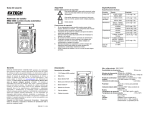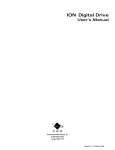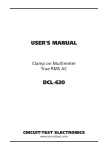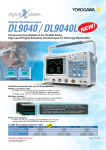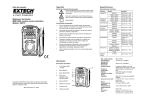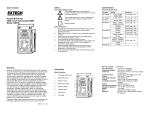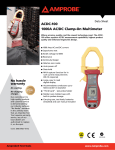Download Reed ST-333 User Manual
Transcript
Model ST-333 400A AC/DC Clamp Meter Pantone 485 & 123 485 = (0/100/100/10) 123 = (0/18/100/0) Instruction Manual www reedinstruments com Table Of Contents Safety..........................................................................................3-4 Meter Description........................................................................... 5 Specifications..............................................................................6-7 Operating Instructions...............................................................8-11 AC/DC Current Measurements.................................................... 8 DC/AC Voltage Measurements..................................................... 8 Resistance & Continuity Measurements....................................... 9 Diode Measurements................................................................... 9 Capacitence Measurements........................................................ 9 Frequency or % duty cycle measurements................................. 10 Temperature Measurements....................................................... 10 Data Hold.................................................................................. 10 Backlight.................................................................................... 11 Zero Button................................................................................ 11 Manual Ranging......................................................................... 11 Battery Replacement................................................................. 11 www reedinstruments com Safety International Safety Symbols This symbol, adjacent to another symbol or terminal, indicates the user must refer to the manual for further information. This symbol, adjacent to a terminal, indicates that, under normal use, hazardous voltages may be present Double insulation Safety Notes • Do not exceed the maximum allowable input range of any function • Do not apply voltage to meter when resistance function is selected. • Set the function switch OFF when the meter is not in use. Warnings • Set function switch to the appropriate position before measuring. • When measuring volts do not switch to current/resistance modes. • Do not measure current on a circuit whose voltage exceeds 240V. • When changing ranges using the selector switch, always disconnect the test leads from the circuit under test. • Do not exceed the maximum rated input limits. Cautions Improper use of this meter can cause damage, shock, injury or death. Read and understand this user manual before operating the meter. • Always remove the test leads before replacing the battery. Inspect the condition of the test leads and the meter itself for any damage before operating the meter. www reedinstruments com Cautions con’t • Repair or replace any damage before use. • Use great care when taking measurements when the voltages are greater than 25VAC rms or 35VDC. These voltages are considered a shock hazard. • Remove the battery if the meter is to be stored for long periods. • Always discharge capacitors and remove power from the device under test before performing Diode, Resistance or Continuity tests. • Voltage checks on electrical outlets can be difficult and misleading because of the uncertainty of connection to the recessed electrical contacts. Other means should be used to ensure that the terminals are not “live”. • If the equipment is used in a manner not specified by the manufacturer, the protection provided by the equipment may be impaired. Input Limits Function A AC,A DC V DC, V AC, Frequency, Duty Cycle Resistance, Diode, Continuity, Capacitance Test Temperature (°C/°F) www Maximum Input 400A 600V DC/AC 250V DC/AC 60V DC/24V AC reedinstruments com Meter Description 1- 2- 3- 4- 5- 6- 7- 8- 9- 10- 11- 12- Current Clamp Clamp Trigger Rotary Function Switch LCD Display ZERO Button Data Hold and Backlight Button Mode Select Button Range Delect Button Hz/% Duty Button COM Input Jack V Ω °C/°F Jack Battery Cover Display Descriptions 1. DC AC Direct Currrent Alternating Current 2. Minus Sign 3. 4000 Count . (0 to 3999) . Measurement Reading 4. AUTO AutoRange Mode 5. ZERO ZERO Mode 6. Diode Test Mode 7. Audible Continuity 8. HOLD 9. °C/°F, m, V, A, K, M, Ω Units of Measure List Data Hold Mode www reedinstruments com Specifications Function Range & Resolution Accuracy (% of reading) 0~20.00ADC ± (2.5% + 6 digits) 20.00~40.00ADC ± (3% + 6 digits) 0~300.0ADC ± (2.5% + 6 digits) 400.0 ADC 300.0~400.0ADC ± (3.5% + 6 digits) 0~20.00AAC ± (3% + 10 digits) 40.00 AAC 20.00~40.00AAC ± (5% + 10 digits) 0~300.0AAC ± (3% + 10 digits) 400.0 AAC 300.0~400.0AAC ± (5% + 10 digits) 400.0 mVDC ± (0.8% + 3 digits) 4.000 VDC 40.00 VDC ± (1.5% + 3 digits) 400.0 VDC ± (2.0% + 3 digits) 600 VDC 400.0 mVAC ± (1.0% + 10 digits) 4.000 VAC 40.00 VAC ± (2.0% + 5 digits) 400.0 VAC ± (2.0% + 5 digits) 600 VAC 400.0 Ω ± (1.0% + 4 digits) 4.000KΩ 40.00KΩ ± (1.5% + 2 digits) 400.0KΩ ± (2.5% + 3 digits) 4.000MΩ 40.00MΩ ± (3.5% + 5 digits) 40.00nF ±(5.0% reading + 30 digits) 400.0nF ±(3.0% reading + 5 digits) 4.000μF ±(3.5% reading + 5 digits) 40.00μF ±(5.0% reading + 5 digits) 100.0μF ±(1.5% reading + 5 digits) 5.000Hz 50.00Hz ±(1.2% reading + 2 digits) 500.0Hz Sensitivity: 5~5kHz:10Vrms min. 5.000kHz 5kHz~150kHz:40Vrms min. @ 20% 50.00kHz to 80% duty cycle 150.0kHz ±(1.2% reading + 2 digits) 0.5 to 99.0% Pulse width: 100µs - 100ms, Frequency: 5Hz to 150kHz;. Sensitivity: 5~5kHz:10Vrms min.5kHz~150kHz:40Vrms min. -50.0 to -20.0°C ± 7°C -50.0 to 400.0°C -20.0 to 400.0°C ±(3.0% reading + 5 °C) 400 to 1000°C 400 to 1000°C -50.0 to 0°F ± 14°F -58.0 to 400.0°F 0 to 400.0°F ±(3.0% reading + 7°F) 400 to 1832°F 400 to 1832°F 40.00 ADC DC Current AC Current DC Voltage AC Voltage Resistance Capacitance Frequency Duty Cycle Temp (type-K) (probe accuracy not included) www reedinstruments com Specifications con’t Clamp Size Opening 0.9” (23mm) approx Diode Test Test current of 0.3mA typical; . Open circuit voltage 1.5V DC typical. Continuity Check Threshold <150Ω; Test current < 1mA Low Battery Indication “ ” is displayed Overrange Indication “OL” is displayed Measurements Rate 2 per second, nominal Input Impedance 7.8MΩ (VDC and VAC) Display 4000 counts LCD AC Current 50/60Hz (AAC) AC Voltage Bandwidth 50/400Hz (VAC) Operating Temperature 14 to 122°F (-10 to 50°C) Storage Temperature -14 to 140°F (-30 to 60°C) Relative Humidity 90% (0°C to 30°C); 75% (30°C to 40°C);. 45% (40°C to 50°C) Altitude Operating: 3000m; Storage 10,000m Over Voltage Category III 600V Battery Two 1.5V “AAA” Batteries Auto OFF approx. 30 minutes Dimensions/Weight 200 x 50 x 35mm/200g Safety For indoor use and in accordance with Overvoltage . Category II, Pollution Degree 2. Category II includes . local level, appliance, portable equipment, etc., with. transient overvoltages less than Overvoltage Cat. III www reedinstruments com Operation NOTICE: Read and understand all warning and precaution statements listed in the safety section of this operation manual prior . to using this meter. Set the function select switch to the OFF position when the meter is not in use. AC/DC Current Measurements WARNING: Ensure that the test leads are disconnected from the meter before making current clamp measurements. 1.Set the Function switch to the 400ADC, 40ADC, 400AAC or 40AAC range. If the range of the measured is not known, select the higher range first then move to the lower range if necessary. 2.Press the trigger to open jaw. Fully enclose one conductor to be measured. 3.The clamp meter LCD will display the reading. DC/AC Voltage Measurements 1.Insert the black test lead into the negative COM terminal and the red test lead into the positive V terminal. 2.Set the function switch to the V position. 3.Select AC or DC with the MODE button. 4.Connect the test leads in parallel to the circuit under test. 5.Read the voltage measurement on the LCD display. www reedinstruments com Resistance and Continuity Measurements 1.Insert the black test lead into the negative COM terminal and the red test lead into the positive terminal. 2.Set the function switch to the Ω position. 3.Use the multifunction MODE button to select resistance. 4.Touch the test probe tips across the circuit or component under test. . It is best to disconnect one side of the device under test so the rest of the circuit will not interfere with the resistance reading. 5.For Resistance tests, read the resistance on the LCD display. 6.For Continuity tests, if the resistance is < 150Ω, a tone will sound. Diode Measurements 1.Insert the black test lead banana plug into the negative COM jack and the red test lead banana plug into the positive diode jack. 2.Turn the rotary switch to the position. ” appears in the display. 3.Press the MODE button until “ 4.Touch the test probes to the diode under test. Forward voltage will . indicate 0.4V to 0.7V. Reverse voltage will indicate “OL”. Shorted . devices will indicate near 0mV and an open device will indicate “OL” . in both polarities. Capacitance Measurements WARNING: To avoid electric shock, disconnect power to the unit . under test and discharge all capacitors before taking any capacitance measurements. Remove the batteries and unplug the line cords. 1.Set the rotary function switch to the cap position. 2.Insert the black test lead banana plug into the negative (COM) jack. Insert the red test lead banana plug into the positive (V) jack. 3.Touch the test leads to the capacitor to be tested. 4.Read the capacitance value in the display. www reedinstruments com Frequency or % duty cycle measurements 1.Set the rotary function switch to the “VDC/AC,Hz/%” position. 2.Insert the black lead banana plug into the negative COM jack and the red test lead banana plug into the positive V jack. 3.Select Hz or % duty with the Hz/% button. 4.Touch the test probe tips to the circuit under test. 5.Read the frequency on the display. Temperature Measurements WARNING: To avoid electric shock, disconnect both test probes from any source of voltage before making a temperature measurement. 1.Set the function switch to TEMP. 2.Insert the Temperature Probe into the negative (COM) and the V jacks, making sure to observe the correct polarity. 3.Select °C or °F with the MODE button. 4.Touch the Temperature Probe head to the part whose temperature you wish to measure. Keep the probe touching the part under test until the reading stabilizes (about 30 seconds). 5.Read the temperature in the display. The digital reading will indicate the proper decimal point and value. WARNING: To avoid electric shock, be sure the thermocouple has been removed before changing to another measurement function. Data Hold To freeze the LCD meter reading, press the data hold button. The data hold button is located on the left side of the meter (top button). While data hold is active, the HOLD display icon appears on the LCD. Press the data hold button again to return to normal operation. Note: The HOLD feature will activate when the Backlight is turned on. Press the HOLD key again to exit Hold. www reedinstruments com 10 Backlight key for >1 second to turn on or off the Press and hold the HOLD the display backlight function. Note: The HOLD feature will activate when the Backlight is turned on. Press the HOLD key again to exit Hold. Zero Button For DCA and Capacitance Zero & Offset adjustment. Manual Ranging The meter turns on in the autoranging mode. Press the Range button to go to manual ranging. Each press of the range button will step to the next range as indicated by the units and decimal point location. Press and hold the Range button for two seconds to return to autoranging. Manual ranging does not function in the AC Current, Diode and Continuity check functions. Battery Replacement 1.Remove the one rear Phillips head screw 2.Open the battery compartment 3.Replace the required two “AAA” batteries (UM4 R03) 4.Re-assemble the meter For service on this or any other REED product, contact REED Instruments at 1-800-561-8187 or [email protected]. www reedinstruments com 11












